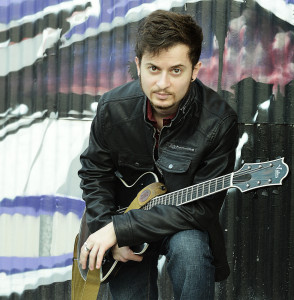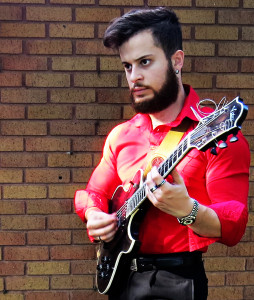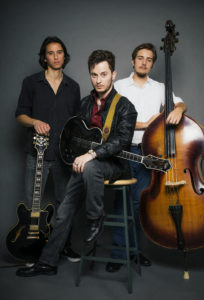
Armen-Gurgen Movsesyan is just getting started as a heavyweight jazz guitarist at 24, but how about playing your college graduation with Abe Laboriel and Ndugu Chandler to kick things off? JGS is very pleased to have as a new artist this young wunderkind jazz guitarist from Denton TX. You may not have heard of him yet, but you will soon, and for many years to come – he’s that good….
DP: So, let me start off with the correct pronunciation of your name:
AM: That is a common question and has been a point of professional concern for me, whether I should change my name or not as an artist (laughs) My full first name is Armen-Gurgen, and the last name is just three syllables: “Mov-ses – YONâ€.
DP: Well, I think it comes down to that whatever you decide to brand yourself with will work for you.
AM: Right!
DP: Where are you from originally, have you always lived in the United States?
AM: What I have is a Russian citizenship, and I lived a lot of my childhood over there. My parents moved here because of a business venture that they had in mind, which is doing pretty well now, but that’s only because of many years of hard work.
DP: So how old were you when you got to the United States?
AM: I first visited when I was eight, and then I came back when I was about 14. Then I got my citizenship in 2012.
DP: When did you start playing music?
AM: Well, my parents – as all parents who are foreign do – put me on piano lessons…
DP: Oh really? How old were you then?
AM: I was seven or eight, and I did classical piano lessons for about 10 years. The reason why I stopped is because there wasn’t any room for creativity other than how you interpret it, which got really boring after a while.
DP: I hear you! So how did the “guitar bug†bite you?
AM: My father had a guitar that he got in Armenia, where I am from, and he gave it to me….and frankly, it was the WORST guitar I’ve ever had! (both laughing) It had the worst action and the worst neck I’ve ever had, but I liked the fact that you could carry it and I liked the fact that you could bend on it, and do swing comping – if you “chug†on a piano, it would sound HORRIBLE! (laughs) So I didn’t go back after that!
DP: What kind of music were you listening to then?
AM: My father actually put me on Louis Armstrong, so that was my first real introduction to jazz music. I would say that I listened to older jazz than anything else.
DP: Like what?
AM: Like Dixieland, like (Bix) Beiderbecke, like Charlie Christian, like Django Reinhart – I was OBSESSED with Django Reinhart! I learned all of his solos, I think that’s entirely why I play the music I do now, because of Django.

DP: My dog’s name is Django!
AM: Yeah? That’s cool!
DP: So what age were you when you started playing guitar?
AM: I was about 16-17.
DP: And right now you are what age?
AM: I’m about to be 24.
DP:….16 or……you’ve only been playing guitar for….
AM: Six or seven years, yes.
DP: Whoa………….that….blows me away…..
AM: You know……I see what you mean, and thank you, but you’d have to understand how obsessed I was and am. If anyone put the amount of hours I put into it, they could definitely see a LOT of improvement.
DP: Well, the learning materials available these days are amazing – when I was coming up, there was the Mickey Baker Method, and then there was the Mickey Baker Method….but what are you talking about in hours? What did you do exactly?
AM: Well, for the longest time I would practice anything that came to mind without any real structure. Anything that I really liked I would first learn by ear….I didn’t really know how to read music on the guitar – of course, I knew how to read on the piano, because of the lessons, but on guitar I didn’t really read music for a really long time.
DP: Well, it’s a really hard instrument to read on….
AM: Yes, it’s a really hard instrument to read on, but I wanted it to be fun for me….I never thought that I would be doing guitar professionally…..not even an INKLING of thought…..
DP: Wow!! (laughs)
AM: So I think that it’s only because of that freedom that I gave myself. I played ALL THE TIME, actually…I played ALL the time.
DP: Who were your first guitar heroes?
AM: Well, of course Django….I remember one summer I was really practicing a lot because school was out – and I really liked practicing when school was out because you have no responsibilities – and I probably spent 6-8 hours a say just listening to and transcribing Gypsy jazz, and eating ice cream. That’s all I would eat, because I never made a single damn dinner for myself, not a single one! Because all I was doing was practicing!
DP: Â So did you do all the Gypsy jazz guitar fingerings where you are more going up a string than across the neck?
AM: I think that kind of thing is more because they really want to play like violinists, where violinists use the entirety of the neck.
DP: See, I thought it was just because of….
AM: And Django’s two fingers….
DP: Yeah, I thought that was a lot of it…
AM: That’s absolutely true, but Django was super influenced by (violinist) Stephan Grappelli’s playing, which a lot of people don’t realize.
DP: Have you ever gone to that big Django festival in France?
AM: No, but I REALLY, REALLY want to go – the day is coming, it’s very close!

DP: And when you went to college, did you do that with the purpose of studying music, or was it something else at first?
AM: I was going to be a physics major….and, I don’t know what was going on…I don’t remember what college I got into, I think it was The University of Chicago, and I was going to go there for physics, but then at the last second I got a scholarship to USC (University of Southern California), and something in me just clicked – I knew I would never be happy being a physicist, and I went immediately into the jazz guitar program at USC – there you go.
DP: Did you say that Steve Trovato (my friend and ex-MI instructor) was your teacher there?
AM: For the first two years, I was studying privately with Steve Trovato. And he kind of mentored me, he told me about all of the things that I was doing wrong, because I was so self taught, you know?
DP: Like what? I watch your right hand, and you just seem to do the most efficient thing for every musical situation –pick it the best way that you could do it, you know? If it should be swept, if it should be hammered, if it should be alternate picked, if it should be economy picked, you know all of those things.
AM: Well….first of all, thank you, but second of all, I don’t think that I know all of those things. I’d like to think that I am getting better, and it comes from being so obsessed, but it causes a lot of problems in my life in other places! (Laughs) It does give me a great picking technique, that’s about it! But I had terrible tendinitis, so I had no choice!
DP: Tendinitis! In what hand?
AM: In my picking hand. I had to change my technique drastically, otherwise doctors were telling me “don’t play for a year†– conservative estimates were six months, and I’m like “I can’t stop playing guitar for six months!â€.
DP: So how did you used to pick as compared to how you pick now?
AM: Playing fast was never so much of an issue for me, but what was an issue for me was playing without tension. I would play with SO MUCH tension in the wrist.
DP: And that’s what I see now: your hands look SO RELAXED.
AM: I had to, if I didn’t, I’d be walking around every day with a cast. When it gets to the point that you’re laying down or whatever and your wrist hurts, you can’t keep going the way you’re going, you know?
DP: I’ve known a lot of people that have gotten tendinitis over the years, and it’s usually been over repetitive stuff, where they just kept doing the same thing over and over.
AM: It’s not just what you are doing all of the time, it’s the way you are doing it too. That’s something that is missing from the diagnosis, the repetitive motion, it’s the way you are doing things (holds out hand and makes rotary wrist motion), if you are doing this, you can do it for 20 hours a day. Because it takes virtually no effort to rotate the wrist. So I think that players that figure this out, don’t have to quit, or change instruments – if you just work on your technique, you can resolve 90% of the problem at least.
DP: Right – so, what I didn’t tell you is that I am left handed and play right handed, and I have had to work really hard on my right hand picking. I have done I think 4 major picking technique shifts in my life. What I started doing was something I used to see Pat Metheny do with two fingers and a thumb, with all of the tension being in the forearm. Eventually I got to the rotary wrist action when I was a student at MI, and now I’ve gotten inspired to modify that from watching you. I used to have my fingers curled into my hand with my little finger sort of out keeping contact with the guitar, but now I having all of the fingers out like you have. I think it took a long time to develop the strength in my right hand where I could do that and still keep control of the pick.
But what did YOU actually do when you knew that you had to make changes? You knew that the big issue was relaxation – what were the principles that you decided to employ?
AM: To tell you the truth, I just listened to my body. A lot of people were telling me to go into the Alexander Technique and take an Alexander Technique class, (Note: This is used by the great Julian Lage amongst others, it shows you the best and most ergonomic way to do anything you need to do with your body) and I’m sure that would have benefited me just as much if not more, but I went the intuitive route where I just said “why does my wrist hurt right now?â€
It started with paying attention to when my wrist started to hurt and then asking myself “what the hell am I doing that’s causing this much pain?â€, and then I looked at my arm, and I said “Oh, my elbow is really screwed upâ€, and then I looked at my shoulder and it was all hunched over all the time. So after a few years of looking at this, it just got better. But still to this day, there are still certain lines and licks that I still can’t do very well – the guitar is just so frustrating in that way!
DP: Well, everybody has that – what I have done over the years is that if I couldn’t do something one way, I would just look for another way that was better for me…
AM: Exactly.
DP: So who are the players that you listen to now?
AM: Actually, I still listen to quite a few of those Gypsy players that I admired when I was starting out. This is my shout out going out to Adrian Moignard and Benoit Convert, Bireli Lagrene and all of those fellas – man, they SUPER inspired me!
Also I am watching a lot of Peter Bernstein: I love Peter Bernstein, I love Kurt Rosenwinkel – the modern guys that are really getting it done in the scene. Mike Moreno….
DP: Yup, I figured you were going to say him…
AM: Lage Lund, Jessie Van Ruller, Martijn van Iterson up there in Amsterdam….man, I try to listen to as many different players as I can find, all the time.
DP: What type of live stuff do you do? Do you do trio gigs? What?
AM: Currently I am playing with my band, it’s my project – we are recoding an album, and planning a tour. That’s sort of my own take on jazz music combining jazz with Armenian music, which I grew up with, and rock.
DP: What’s the name of the band?
AM: “Ararat†– it’s the name of the mountain where Noah’s Ark landed. I’m in a band with a whole bunch of local people (Denton, TX) where we play a variety of styles: flamenco jazz, straight ahead stuff….
DP: Are you a guy that digested the Real Book and standards – do you know that vocabulary?
AM: I probably know at least a few hundred tunes…I’m not going to lie and say that I practice tunes that much anymore. I used to practice tunes a LOT, and I think everybody SHOULD, because the language comes from the melodies in these old show tunes and pop tunes. But right now I am writing more than anything and I am refining a lot.
DP: So you’re writing for your band, right? What is that band – who’s in it?
DP: The band is a saxophonist, Emilio Mesa; a vocalist Anna Jalkéus, and Henry Dickhoff – there’s a lot of people in this band, Henry Beal, Daniel Beckwith, and myself. I write everything. And Tigran Hamasyan – he won the Thelonius Monk Competition in 2006, he’s fantastic, a jazz pianist. He’s the first to be able to commercially combine Armenian music with jazz, in the United States at least. He really, really super inspired me, because I had always heard the sound in my mind, but I had never heard anyone do it before.

DP: Is there a lot of odd meter?
AM: There’s a lot of odd meter, yes. We are going on a tour of the US soon.
DP: Are you going to play colleges?
AM: We may play colleges, but I doubt it – it’s a little heavy. Thrash heavy metal stuff…
DP: REALLY?
AM: Yeah, because the thing about that kind of music is that it’s really visceral, really – it’s certainly loud, it’s energetic, you know?
DP: So what gear do you use in this band?
AM: I’m either playing through an old Vox AC-30 or a Fender Hot Rod Deluxe. And I just use the distortion on the amp, that’s it. UPDATE: I just got an AX8 by Fractal, the multi-effects floor unit. Best purchase I’ve ever made. It has replaced all my pedals. My main amp now is the Henriksen JazzAmp
DP: What’s the guitar?
AM: The guitar I use is a Michael Viteri Custom. http://viteriguitars.com/  He’s a great friend of mine in Houston and a fantastic luthier, I only play his guitars and I have an archtop and a solid body. My archtop is a 17†European spruce top and maple sides, 25†scale, with a Kent Armstrong 12 pole floating humbucker. My solid body is all mahogany with a 25†scale with a 1.25†body thickness and has tone chambers. Both guitars have ebony fingerboards. I use a heavy pick, 1.5mm.
I’ve recently purchased an AX8 by Fractal, the multi-effects floor unit. It has replaced all of my pedals except for the Hog 1 which RAT. I just like the original sound of those two, they aren’t replaceable to my ears. Other than that, Fractal’s unit is incredible. I don’t think I’ll be needing to mess with pedals any more, at least for a while. Occasionally, though, I’ll still use my Tube Screamer, Hall of Fame, Flashback board when I don’t need very wild sounds. But, at the end of the day, my favorite way to go is a nice amp and my box.
DP: Any closing thoughts?
AM: I Â just want to thank everyone so far that has supported my work, checked out my products, reached out to me for collaborations or just to say hello. I feel extremely lucky.
Armen Movsesyan is currently working on finishing his masters degree in jazz guitar and teaching in Denton TX. Watch for his live gigs, tours and new CD projects, and keep up with what he is doing on his YouTube Channel:
https://www.youtube.com/user/xemosintightsx
Instagram: https://www.instagram.com/armenmovsesyanmusic/</
em>